Two days in Dublin: fundraising inspiration in Ireland’s capital – part three
SOFII’s four-part feature recording edited highlights from one of 2016’s best world-class fundraising conferences
- Written by
- Joe Burnett
- Added
- November 10, 2016
In this edition of SOFII’s report on the Ask Direct Summer School, we are treated to a long-overdue debate on the problems of gender imbalance in fundraising featuring four amazing women fundraisers. We also take a look at best practices in getting more web donations by Norwegian consultant and passionate enthusiast for the medium Beate Sørum.
Rory Green, Simone Joyaux, Niamh Ferris and Jen Love
Fixing the gender imbalance in fundraising
A major highlight among a wealth of great moments at Summer School was held on the first afternoon, as Rory Green, Simone Joyaux, Niamh Ferris and Jen Love drew attention to a too often overlooked and uncomfortable reality in the voluntary sector. In an industry that aims to make the world a better a place there remains a severe gender imbalance in terms of pay and representation at the highest levels of organisations’ administration.

As Rory Green put it, ‘we are all fighting for a fair and just world, but even our organisations are failing’.
Simone Joyaux, whose excellent workshop on extraordinary experiences we covered in part two, highlighted her own case as a way of explaining unearned privilege. ‘I win, except for gender’. Although the debate mainly centred on questions of gender imbalance, Simone used the discussion as a way to widen the question, noting that as a white, heterosexual, well-educated and wealthy woman she inherently has a privileged position compared to many in society. And that privilege is even greater for white, heterosexual, well-educated, wealthy men. The video she then showed (below) explored the notion of unearned privilege and the effects it can have even further
There can’t have been too many dry eyes in the room at that point and, as Simone says, we won’t move forward unless we have conversations about these issues with our work colleagues.
Simone highlights the difference between equity and equality, using a handy visual metaphor:
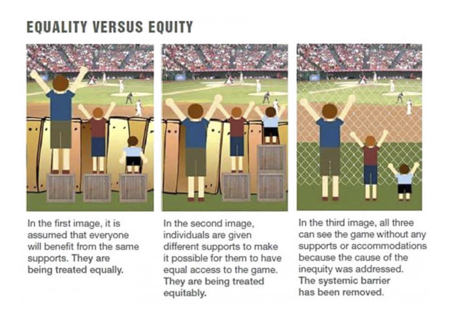
Equity means more than treating people equally, it means removing the barriers that systemically prevent people from accessing the same resources. Fighting for equity is a fight against bias and privilege, earned or unearned. Simone’s last question to the audience was more of a challenge: ‘what rules do we want to accomplish this?’
Niamh Ferris, regular giving manager for the Royal College of Surgeons in Ireland, followed Simone by bringing the stark reality of gender imbalance in the third sector into focus. The RCSI was founded in 1784, but it wasn’t until 1885, over 100 years later, that Emily Dickson became the first woman to qualify as a surgeon there. And it wasn’t until 2010 that the RCSI appointed its first female dean, the same year that Ireland elected its first female president. Progress is progress, but it’s slow, even in the voluntary sector. In Ireland, 67 per cent of fundraisers are women, but only 48 per cent of directors or heads of fundraising are. The gender pay gap is a shocking 16 per cent. And this pay gap actualy increases as women move up the ranks of their organisations.
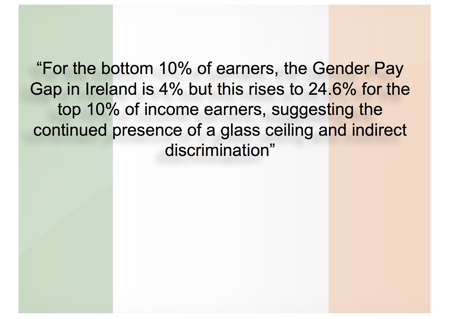
So the next time someone tells you the glass ceiling doesn’t exist, show them these figures. The figures are just as unacceptable on the other side of the Irish sea: in the UK, only 32 per cent of charity directors are women and on average they are paid 22 per cent less than male counterparts. In the USA, the gap is 21 per cent, suggesting an endemic problem. Niamh Ferris is optimistic that we are uniquely placed to achieve change, but challenges us all to think about how we can do it.
Canadian fundraising expert Rory Green took up the reins to directly address a question that probably lies in the minds of too many CEOs and board members: ‘why should I care?’. The answer is really rather simple: ‘teams with diversity solve problems better’. And as we’re all in the business of solving problems, diversity can only be a good thing.
Rory recognises that subconscious bias is natural, meaning that higher-paid people are naturally chosen to relate to boards or wealthy donors. Given the pay gap already mentioned above, this is why men are more likely to get chosen for the more important positions. However, if your organisation thinks about its environment, culture, how it advertises new jobs and aims for a more diverse workplace this will lead to better communications and more innovation. Studies show that diverse teams innovate more and communicate better; that means your organisation will raise more money.
It clearly works: Salesforce, the software company, mandates that there be a 50 per cent gender parity amongst its staff. If you add in blind interviews, and advocate mentorship over sponsorship, your organisation is more likely to perform more efficiently. After all, we’d all like to be as successful as Salesforce.
The final panellist, Jen Love of Canada’s Agents of Good, reiterated that charities are engines of social change, that change is measured in real impacts and shared with storytelling. For this to be effective, organisations need to develop emotional intelligence.
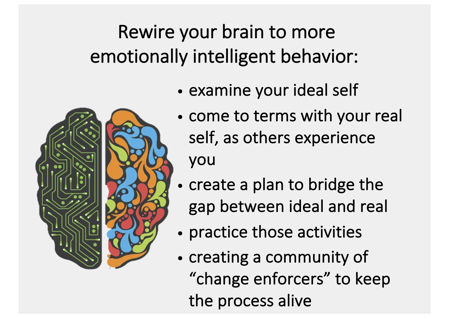
The emotional state and openness of your organisation’s leaders affect the behaviour of staff and, therefore, the results. Companies that promote emotional intelligence and communicate accordingly will always do better.
With Rory Green and Jen Love laying out the benefits that more diversity can have on organisations in response to the critical issues and imbalances outlined by Simone Joyaux and Niamh Ferris, it’s clear that we have an unique opportunity as a sector to forge a more equitable and fair path and become a beacon for other sections of the professional sphere. At the end of the debate, all present were encouraged to reflect on their wishes and status and to commit, at least to themselves, to act in a way that will start to redress the balance. We can do it, we just need to change how we think.
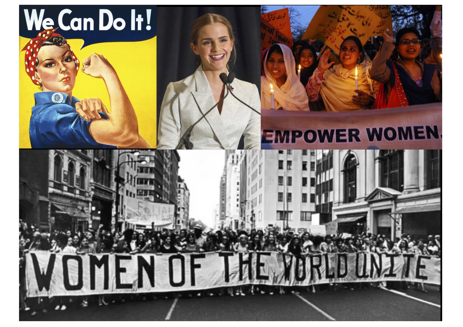
Keep an eye out for SOFII’s soon-to-be-launched campaign on rectifying the gender imbalance in fundraising. We’ll be getting testimony from women working in the sector from around the world, so they can tell their stories of how gender inequality has affected them and how they think the situation can be resolved. If you would like to be involved, please e-mail joe@sofii.org
Beate Sørum
From good intentions to more web donations
The internet has provided a rich opportunity to develop new ideas and nowhere more so than in fundraising, but Beate Sørum’s session quickly demonstrated that charities are not making the best use of this relatively new technology. The humorous quote below – made up by Beate – shows where so many of us go wrong.

Beate, who says she owes her career to how she mastered Twitter, pointed out that, according to a Lloyd’s Bank UK digital index report of 2015, ‘the most digially mature charities are twice as likely to see an increase in funding.’ However, too many charities go for the cheapest option when building a website, seeing it as a cost and not an investment no matter how easy it can be to buy a good website.
When considering your websites, you should bear in mind that giving is an emotional decision, not a rational one, Beate reminds us. She recommends mapping the journey donors will make through the website, from their emotional reaction to a powerful story to the place where they can make their gift. Too often it can go like this:
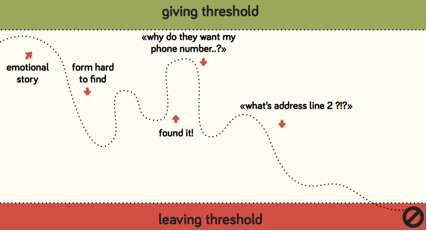
It’s crucial not to overestimate donor patience. As Beate said, ‘If they are thinking about your form, they are not thinking about giving.’ As such, it is essential to remove unnecessary steps and all ambiguity.
Beate then took us through what a good donation form on a website should look like, dismantling a few preconceptions along the way.
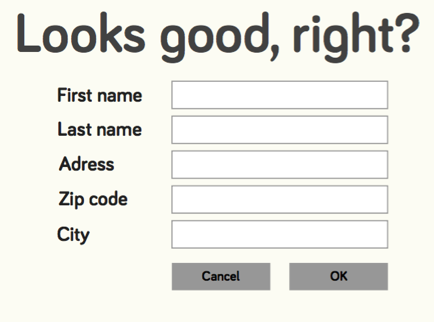
In fact, this form is pretty much as bad as it could be and Beate took us through what should be changed to shorten donors’ time spent completing them:
- Adapt fields according to the information.
- Group relevant fields together.
- Clear away unnecessary buttons.
- Make the ‘donate’ button bigger.
- Align field names and the fields (top align for mobile)
- Don’t put text in fields
- Clearly explain errors.
- No CAPTCHAs:
- The database is not in charge. Just because your database has a field for something does not mean you need to ask for it.
- Every extra field costs you donors. An organisation Beate worked with agreed to reduce their form from 11 to four fields and submissions went up 140 per cent.
You can read a detailed description of how best to design a form in Beate’s article ‘Ten easy fixes for the design of your donation form’ on SOFII.
She gave an example of a form done well, as follows:

A short form such as the above does not preclude an upgrade later. Beate advises to think of forms as a conversation, meaning charities can ask follow-up questions when the first form is filled out.

Too often, Beate warns, the crucial ‘donate’ button is too easy to miss and looks like advertising, leading organisations to have to guide users.
When working on or building a website, you should ask:
- Why do we have a website?
- What do our website users need?
Beate cited the case of the Norwegian Cancer Society, who surveyed their website users and discovered that 25 per cent visited the site for the six following reasons:
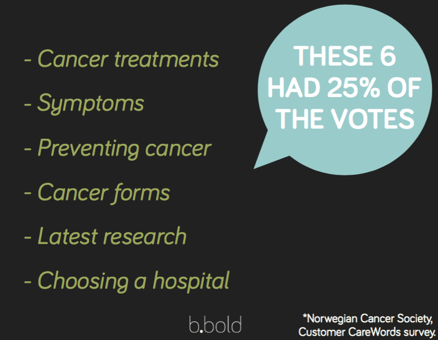
Users were not looking to make a donation but for information. As such, the core pages of their website were redesigned to centre on the points where user needs overlapped with the business goals, removing those that weren’t relevant. This follows the ‘core model’ explained below:
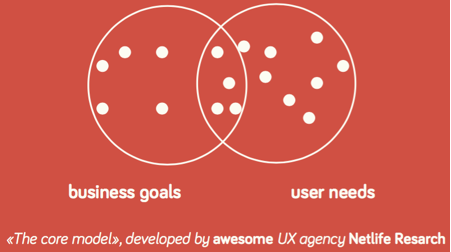

As you can see, once the core pages are established based on overlapping user needs and business goals, they can be used to lead to business goals that aren’t shared with the user needs, as per below.
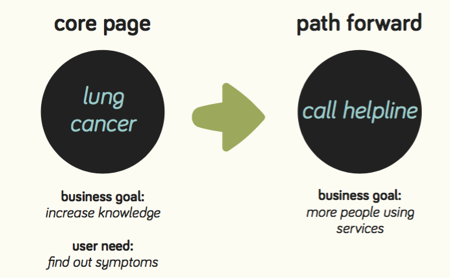
Beate’s advice is to make the donate button portable and put it on all relevant pages, which is what she did with the Norwegian Cancer Society.
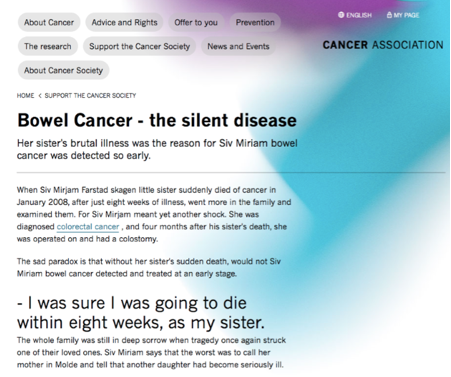
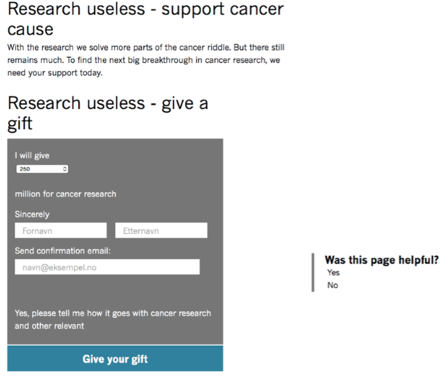
An example of a good way to include a donate section on a page from the Norwegian Cancer Society. (please note that Google translated the Norwegian text above the form to ‘research useless’ for some reason. The original text was that research can’t be accomplished without donations, which makes more sense!).
In other words:

It’s important, Beate said, to make priorities and avoid too much choice. The paradox of choice is that the more choice we have, the less likely we are to buy. As a fundraiser, you must prioritise. An example is the number of different payment amounts offered to donors – use too many and you’ll only bewilder them. Here’s an example with a membership scheme:
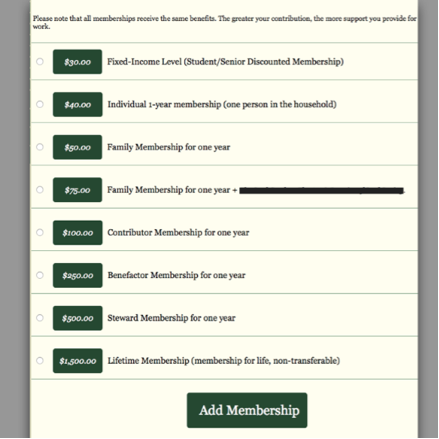
Conversely, one organisation took Beate’s advice and ended up with a much simpler field, with just three categories at the top, space to add personal details (name and address only) and also a short section offering people to add someone extra to the membership for only kr 75, i.e. eight euros extra. Approximately 30 per cent of users selected this option on top of their own subscription.
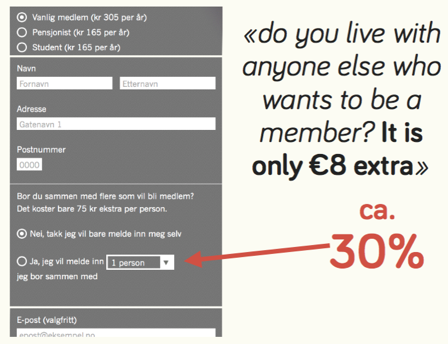
Beate then discussed the issue of anchoring bias, a process whereby we humans hone in on the first piece of information we receive. Two people presented with the same set of adjectives to describe someone (kind, handsome, funny, jealous and stingy) will have radically different preconceptions of that person depending on whether the positive traits come before or after the negative ones. And it’s the same with donation amounts. Always put the highest amounts at the top of a list or dropdown menu (oh, and dropdowns are always better than individual boxes).
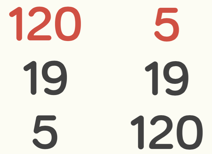
Designed properly, your form need not be anything other than simple to get significant benefits:

Beate is clear: the benefits of making the change from complicated, overly-populated forms to something like the above can be incredible. She gave an example of an organisation that started taking her advice in 2012.: the results really speak for themselves:
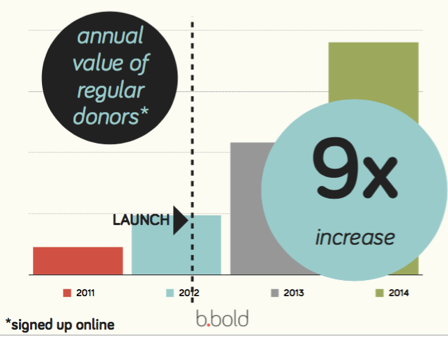
Finally, Beate says, make sure your website is mobile-friendly. Not only is it nicer for users, but it will increase your donor conversions, whether they’re logging straight onto the site or arriving from the likes of Facebook.
A lot of Beate’s points will seem counterintuitive, but just comparing charity websites that follow her advice with those that don’t should convince most people.
In the final part of our report on the Ask Direct Summer School, we’ll be covering the last day’s two major presentations, from fundraising heavyweights Alan Clayton and Ken Burnett, so stayed tuned!

















